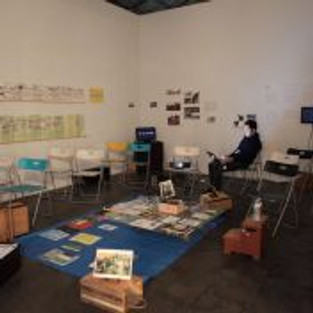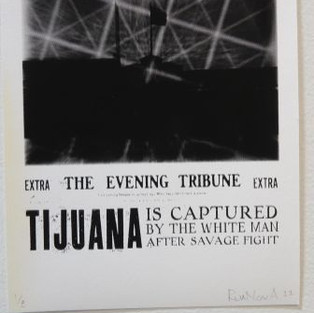Kio Griffith Responds to the Current Socio-Political Climate with “Transit Republic”
- artandcakela
- Mar 15, 2017
- 5 min read

Transit Republic Logo. Photo Courtesy of Kio Griffith.
Kio Griffith Responds to the Current Socio-Political Climate with “Transit Republic”
By Genie Davis
Transit Republic is an incredibly apt name for an exhibition with an international pedigree. The name also describes future exhibitions planned between cities. Held over 25 days from mid-January to early February 2017 at Santa Monica’s Arena 1 Gallery, curator Kio Griffith describes the collective experience as “not just an arts festival but about art and anthropology and a little sociology, all involving journalism and research into history, mankind and culture.”
A heady mixture and a heavy mantle for any exhibition, this one carried it off. With a logo that featured the California state flag reimagined with the changeable chameleon rather than a bear front and center, Transit Republic according to Griffith, “materialized from the tactile necessities of site specific research and the archiving of multifaceted creative disciplines across national and sociopolitical borders of the Pan Pacific realm.”
Griffith adds “We are living in a world separated from the rest of America. I can imagine California landing someplace else like a UFO, and once imagining that, I thought that is a ‘transit republic’, a place in transit moving as it wishes anywhere in the world. When it lands, it is going to be integrated with its surroundings and have influence and good energy.”

Transit Republic. Installation in Process. Photo Courtesy of Kio Griffith.
This idea translated for Griffith and the Transit Republic Collective in the conception of a publishing bureau, a micro-arts festival featuring international cultures, and as a response to the current socio-political landscape. The over-riding purpose of the exhibition was to “weigh the human footprints left on our environment. The objective of this research is the world-making compilation of informative dialogues and findings.” The project’s duration of 25 days coincided with the anniversary timing of — and was inspired by — the short-lived Republic of California that existed between the period of Mexican rule and the state’s annexation by the United States due to the Gold Rush.
“We are trying something different than the way other things are organized, – make an exhibition more about the people involved, including the administrators, tech and staff who usually are affixed to the namesake city of the arts festival. It’s about all of us taking each others’ roles to experience the full scope of the festival’s creation rather than operating in each personnel’s department. You could be both curator and creator – that’s the sort of thing that happened during the course of our 25 days here,” Griffith asserts.
The impetus for this project came about a year ago when Griffith was involved in an arts festival, the Aichi Triennale, held in Japan every three years. Griffith’s sound installation there led to a friendship with the organizers along with an immersive work translating the festival’s catalog. As the three-month-long festival ended, Griffith proposed this idea of a “publication of residence” to festival director Chihiro Minato, also the publisher of Art Bridge magazine.

Transit Republic. From left to right: Chikako Yamashiro, artist, filmmaker. Chihiro Minato, artist, photographer, curator and publisher of Art Bridge, director of Aichi Triennale 2016 and Kio Griffith to the right. Photo Courtesy of Kio Griffith.
“The idea was that this would be an entity that set up camp in Santa Monica in a temporary office space for twenty five days, doing field work, arranging interviews and artist visits, accomplishing research of sorts. Such a project has not been done before in this scope involving an international publication operating on foot in another city,” Griffith relates. Along with Griffith, participants included Japanese artists Chihiro Minato (photographer, director of the 2016 Aichi Triennale), Hiroyuki Hattori (independent curator), Kenichiro Egami (photographer, arts activism researcher), Ayumi Sekikawa (editor in chief, Art Bridge), Megumi Machida (curator of education), and Taiwanese artist and curator J-J Gong.
The artists from Okinawa, Chikako Yamashiro, Kaori Nakasone, Kiyoko Sakata, Satoko Nema, Tohru Kinjo and Futoshi Miyagi deal with the encroachment of U.S. military bases on their living space. Ai Iwane from Fukushima brought her analog panoramic photographs of disaster strewn sites in Hawaii and Fukushima. They came to Los Angeles with the idea of having a voice in that situation, and in exploring gentrification issues here, according to Griffith.
Arena 1 gallery is divided into four different rooms, and Griffith used the space well. One room, dubbed the Project room, was curated by Kenichiro Egami, art activism researcher, curator, and photographer. He created an archive of all artist-run spaces in East Asian countries he’d visited, using reading material, flyers, posters, and video work. The resulting exhibition, emerging from the rubble – Art/Activism against the gentrification in East Asia also led to the study of local gentrification in Boyle Heights, Skid Row, and Inglewood. Egami had a specific interest in exploring these areas along with Watts Towers and a “field trip” to Tijuana.
Another room at Arena 1 served as a library/editorial office space. “When people visited, invite them to sit with us in that space, where we would conduct talks or interviews. We displayed a collection of artists’ books and zines here. In additon, from our trips to Tijuana we borrowed the works of ten artists and exhibited them on the walls in this area of the gallery.” Those artists included: Mely Barragán, Daniel Ruanova, Luis Alonso Sánchez, Tavo Camarena, Haydee Jimenez, Julio Romero, Ingrid Hernández, and Colectivo Coyote.
In the larger main room of the gallery, the group exhibition “Reading Footprints” consisted of photos and a two channel video. “Every work in this show is a reminder of each artist’s cultural background — not to vanish, but alive and assertive, confident of the values of the past, their important of informing the present, and the influence on the future,” Griffith says.

Transit Republic. “Reading Footprints” Ai Iwane’s panoramic photo – grave site from the big island in Hawaii. Photo Courtesy of Kio Griffith.
In this space, visitors could take in Ai Iwane’s wide-angled photography shot on a vintage 1930s panoramic camera, and education curator Megumi Machida’s installation “Crossing Waters,” featured works from Hokkaido and Okinawan artists, the northern most and southern most edges of the Japanese archipelago —Hokkaido artist, Masao Okabe’s aerogrammes arrived daily, featuring rubbings recorded from sites that experienced some form of trauma whether it being from natural or man-made disaster.
An adjoining long and narrow space was used as a screening room, rotating screenings between Chikako Yamashiro’s films and the Hiroyuki Hattori’s curated film series “”Parallel Narratives From The Other Side.” Echo Park Film Center also hosted a screening night of Chikako Yamashiro’s works drawing in a full house of viewers curious about the situation in Okinawa. Another screening event for the Korean director Jung Yong-taek’s film “Party 51” was shown as part of Kenichiro Egami’s programming.
“We’ve come to realize that this micro arts festival could fuction much like the larger counterparts… but in motion” he relates. “Knowing that the project needed to continue, Griffith began to consider important areas to include in future iterations, with the only qualifiers being that each exhibition would pair two locations, one more urban and one more rural.

Transit Republic. Reception for “Reading Footprints” in main room. Photo Courtesy of Kio Griffith.
“There’s one obvious place in Detroit and Toronto, another Hong Kong and Guangzhou, or Mexico City and Havana. Our next iterations will likely be either Detroit or Mexico City next year, but we would like to do a repeat in Los Angeles,” Griffith states.
The findings from the exhibition at Arena 1 were incorporated in the 5th issue of Art Bridge magazine. Art Bridge is an arts research publication funded by Arts Council Tokyo, published by contemporary artist and photographer Chihiro Minato, the same publication that interviewed Griffith for issue 4, and bringing the project full circle as it were — the perfect situation for Transit Republic to explore.
#losangeles #california #losangelesartist #santamonica #AyumiSekikawa #art #Detroit #geniedavis #AiIwane #MelyBarragan #JungYongtaek #inglewood #KenichiroEgami #artexchange #artfestival #emergingfromtherubble #losangelesart #BoyleHeights #ColectivoCoyote #contemporaryart #DanielRuanova #SkidRow #Fukashima #southerncalifornia #HaydeeJimenez #internationalart #ArtBridgeMagazine #tijuana #ProjectRoom #artandcake #toronto #LuisAlonsoSanchez #artexhibition #femaleartists #ArtandCakeLA #fineart #HongKong #artists #artist #artpublishing #TransitRepublic #TavoCamarena #arts #gentrification #thailand #IngridHernandez #artexhibit #CrossingWaters #ArtandCulture #HiroyukiHattori #exhibition #Arena1Gallery #Okinawa #exhibit #MegumiMachida #ChihiroMinato #WattsTowers #JJGong #kiogriffith #losangelesgallery #MasaoOkabe







































